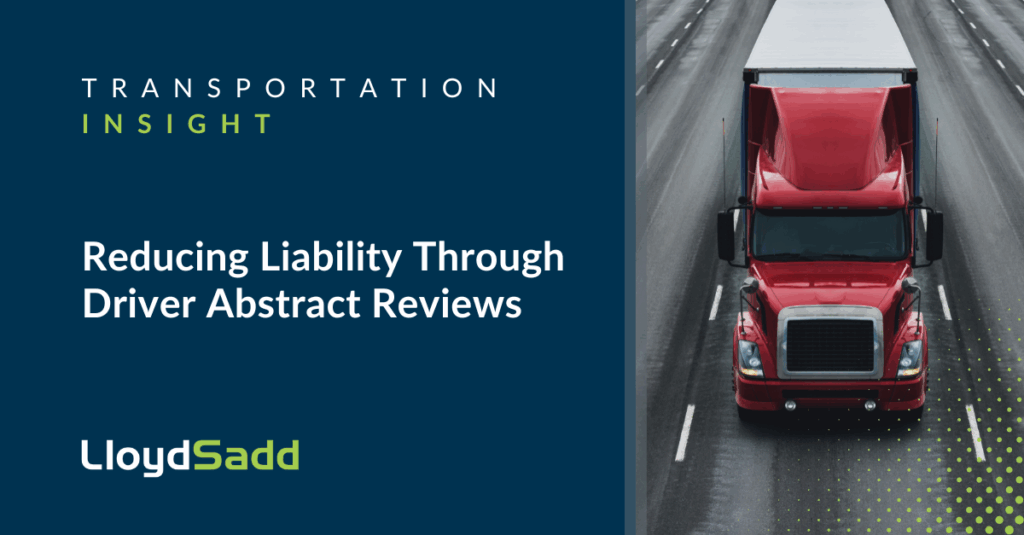Reducing Liability Through Driver Abstract Reviews

By: Kim Hrushenski, Lloyd Sadd
Authorizing someone (employee, volunteer, contractor) to drive a company vehicle creates legal exposure. It’s not enough that they’re licensed – you’re responsible for ensuring they’re capable, competent, and truly qualified.
The discussion that follows concerns “qualified”. The drivers licence issued by the province, territory or state only means the driver has met a minimum standard. “Capable” and “Competent” are needs best discussed with our risk team.
Steps to Ensure Defensible Actions
To ensure that your actions are defensible, to reduce the potential appearance of negligence, there are steps you can take.
Review of Drivers Abstracts
A key step is review of drivers abstracts, and policy & procedure that outlines who you consider qualified to drive your vehicles.
Criteria for Driver Abstracts
Abstracts should be reviewed prior to an offer of employment and then again, at minimum, annually for all drivers regardless of vehicle type or size.
Documented Driver Abstract Criteria
Formal, documented, driver abstract criteria should start with demerit points and/or specified number of minor convictions. A common standard is to specify no more than 6 demerit points and/or 2 minor convictions. (examples are outlined below)
Method of Return within Policy
Along with these criteria it is best to outline a method of return within policy, normally a merit based defensive driving course.
Suspensions & Disqualifications
There are also numerous reasons why a driver’s licence may be suspended (disqualified). You cannot allow a driver who is currently under suspension to drive, and a review of past suspensions is also very important. Not all suspensions are the same and it is best to discuss them with our risk team.
As example a suspension that is older than 3 years with no subsequent convictions since reinstatement is often acceptable as are suspensions for concerns that are not related to driving.
Collision History
Where collision history is known it may also be included as part of the criteria, typically no more than 1 at fault collision in the last 3 years.
What you learn in an abstract review should also inform interview, reference check and performance review processes.
Guidelines and Policy Writing
What follows is only a rough guideline rather than an exhaustive list and none are truly definitive in that underwriters and plaintiffs’ lawyers might argue them from category to category. In writing policy, it is not critical that you are specific, you might refer to this list or reserve the right to determine major/minor based on circumstances at the time of review.
MINOR
- Defective equipment
- Disobeying legal sign
- Driving a motor vehicle or other device in a bus lane
- Driving an unsafe vehicle
- Failure to back up safely
- Failure to change lanes in safety
- Failure to drive in designated lane
- Failure to drive in right-hand lane
- Failure to give way
- Failure to make U-turn safely
- Failure to merge safely
- Failure to obey traffic sign/control device
- Failure to pass in safely
- Failure to proceed as directed at green light
- Failure to proper signal
- Failure to stop as required
- Failure to stop at an uncontrolled right of way
- Failure to stop at railway crossing
- Failure to stop for emergency vehicle
- Failure to yield right of way vehicle/pedestrian
- Following too closely
- Impending traffic/passing vehicle
- Improper right/left turn
- Improperly passing School Bus
- Most speeding violations
- Moving traffic offence other than major/serious
- OOP – red light; out of province disobeying/passing a red light
- Pass/cross solid line(s)
- Passing vehicle at a pedestrian crosswalk
- Unsecured load or overload
- Wrong way on a one-way highway
MAJOR
- Criminal negligence or manslaughter committed in the operation of an automobile
- Dangerous driving
- Distracted driving
- Driving while license is under suspension or disqualified
- Driving without due care and attention (Careless Driving) if convicted under the HTA or TSA this is considered a Major Moving Traffic Violation
- Driving without reasonable consideration for persons using the highway
- Exceeding blood alcohol level permitted by law
- Failure or refusal to submit to a breathalyzer test
- Failure to proceed as directed at green light
- Failure to remain at the scene of an accident
- Failure to stop for a peace officer
- Failure to stop for a School Bus
- Failing to stop at the scene of an accident
- Impaired driving
- Intoxicated driving
- Passing in a school/playground
- Racing if convicted under the HTA or TSA this is considered a Major
- Speeding in a school/playground
- Zero tolerance for alcohol (graduated licensing – Alberta)
Final Thoughts
Ensuring that drivers are capable, competent, and qualified is paramount for minimizing risks and maintaining a safe and efficient operation. By implementing thorough review processes for drivers’ abstracts, establishing clear criteria for qualifications, and maintaining regular checks, organizations can significantly reduce the potential for negligence and enhance their defensibility. Collaboration with risk management teams and adherence to documented policies will further strengthen the organization’s commitment to safety. Ultimately, a well-defined and consistently applied driver qualification policy not only protects the organization but also promotes a culture of responsibility and accountability among drivers. This comprehensive approach will help in achieving long-term success and safety in all driving-related activities.
To download the insight, click here